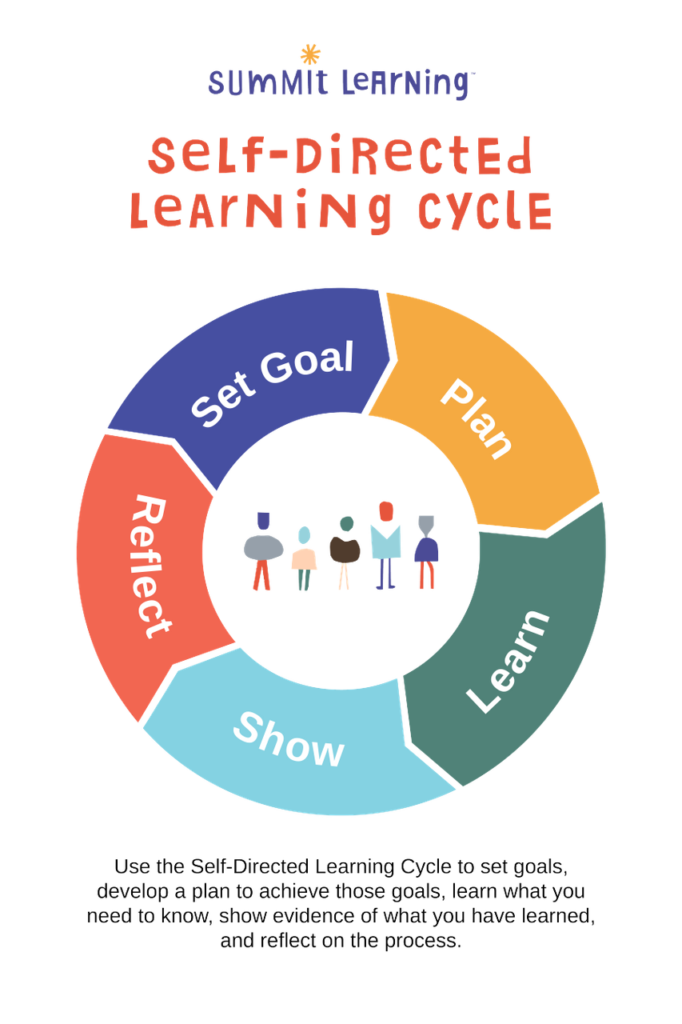
Set Goal. Plan. Learn. Show. Reflect. A foreign agenda for my students, until my 10th and 12th-grade special education classes implemented the Summit Learning Program this school year at Anacostia High School in Washington, D.C.
This “reflection wheel”, or Self-Directed Learning Cycle would soon become the basis of each and every day in my English classes.
The Self-Directed Learning Cycle prompts students to set goals, develop a plan to achieve those goals, learn what they need to know, sow evidence of what they have learned, and reflect on the process.

My students need routine and structure, and you’ll see this wheel “spinning” in their beautiful minds as they work diligently through their 70-minute class period.
Implementing the Self-Directed Learning Cycle in our English class was just one of the many changes we made in our special education classroom during our first year of Summit Learning.
Facing Down the Unfamiliar
In the beginning of the year, I was hesitant about the Summit Learning Program. I’m not sure if my students, or myself for that matter, knew what this year would entail.
It is not easy to begin a school year with a new curriculum, and it’s even more difficult when it’s given to students who need the most assistance academically and behaviorally.
As teachers, we had to learn a new system, while also making modifications and accommodations so that our students can access all material. This was (and still is) a hard part of implementing Summit Learning.
Making Material Truly Accessible
Even though most special educators have used interventions at some point in their careers, these programs or set of steps to help a child improve in an area of need take on a whole new meaning as I lead students through project-based, self-directed and small-group tasks.
A few of the daily techniques I used in order for my students to access their grade-level work on Summit included graphic organizers, paragraph and essay outlines, sentence starters, and leveled texts and assignments.
- Graphic organizers are visual aids, like flow charts or diagrams, that help students organize ideas, see relationships, and retain information.
- Paragraph and essay outlines are guided notes and worksheets that my students can use in order to assist them with their writing assignments.
- Sentence starters provide a partial frame for students to begin their sentence or idea, such as “The first thing that happened was…” or “After that…” They are a helpful writing accommodation in order to get their minds working, and to assist them to get started when they may be stuck on a writing prompt, for example.
- Leveled texts/assignments are books or assignments that cover similar topics over a variety of reading levels. These are made by teachers to reach all students where they are. In other words, it allows all students, regardless of what level they are at, to access the same lesson.
These accommodations were able to empower my students to realize their full potential. For example, one of my high school students with autism is on approximately a second-grade reading level. He was able to participate in a grade-level writing prompt by using a guided note sheet to complete the assignment. He had to find evidence to support his position on a controversial topic, and was able to do so with these supports. He was SO proud of himself, as he should be (and I was proud too!).
A Perceptible Shift
A change occurred, in both my teaching and in my students’ work, when we were entering our third term. I finally had pre-planned, had the ability to look at beginning-of-year data, and plan for the remaining two terms. I felt as though I was successful at the platform itself, and I was ready to assist my students in becoming independent, self-assessing students.
Now, I believe I’ve become more of an efficient educator, and my students have become life-long, independent scholars, who take ownership of their learning.
Looking Forward To A New Year of Opportunity
Now that I understand what it takes to plan for and teach using the Summit Learning personalized approach, I can push myself, my colleagues, and our students to complete more cold tasks, which are exercises at the beginning of every unit, or genre in literacy. I will push them to take their learning outside of the classroom as well, and to become more confident in their abilities.
In addition, I am hoping to increase my students’ self-advocacy skills, and continue to learn from them as much as I hope they learn from me.
Summit Learning makes lessons accessible to a broad spectrum of learning styles and needs. Read more about teacher and student experiences with special education in the Summit Learning Program.

